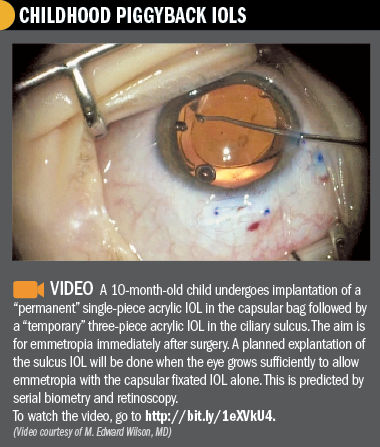Article
Individualized approach to refractive management of the pediatric lens combines art and science
Pediatric cataract surgery is now approached as a refractive procedure in which multiple factors are taken into account to determine the timing of IOL implantation and power selection.
TAKE HOME:
Pediatric cataract surgery is now approached as a refractive procedure in which multiple factors are taken into account to determine the timing of IOL implantation and power selection.

Dr. Wilsom
By Cheryl Guttman Krader; Reviewed by M. Edward Wilson, MD
South Carolina, SC-“The practice of medicine is an art based on science,” Sir William Osler once said.
“There is no place that is more true than in the refractive surgery we call pediatric cataract surgery,” said M. Edward Wilson, MD, professor of ophthalmology and pediatrics, and the N. Edgar Miles Endowed Chair, Albert Florens Storm Eye Institute, Medical University of South Carolina, Charleston.
The modern era of pediatric cataract surgery began in 1976 when Marshall Parks, MD, began performing lensectomy and vitrectomy, according to Dr. Wilson.

Though the operation has stayed similar in many respects, it is now being approached as a refractive surgery. However, there is no nomogram for guiding the refractive management of the pediatric lens, he noted.
“We use a multifactorial approach to choose the timing of IOL implantation and power selection for each patient,” Dr. Wilson said. “Then we track axial eye growth, myopic shift, eye development, and IOP over the long term, and from the time of the initial surgery, we prepare the family for refractive surgeries with supplementary IOLs, IOL exchange, and laser vision correction procedures in the second and third decades.”
Factors considered in the refractive management decision for the individual patient include age, visual acuity and prognosis, status of the other eye, interocular axial length difference (IALD), expected compliance with treatment (glasses, contact lenses, occlusion therapy), and what is thought would be an acceptable amount of late myopia for this patient.
Dr. Wilson noted that his institution has collected preoperative and serial postoperative data from more than 1,200 pediatric cataract and IOL surgeries and is mining this tremendous resource to understand factors influencing outcomes and ways to refine patient management.
For example, IALD is considered as a factor for IOL power selection based on analyses that showed it both predicted and was modulated by visual acuity.1,2
The IOL power might be chosen to provide less residual hyperopia when the cataract eye is longer than the fellow eye, because it is likely to slow its future growth (and reduce the IALD) after surgery, Dr. Wilson explained.
IOL power might be chosen to result in more residual hyperopia in a shorter eye that would be expected to grow faster than normal (again reducing the IALD) after surgery. A target of emmetropia might be chosen for an eye predicted to need intense patching for dense amblyopia if poor postoperative compliance with glasses is expected.
The latter approach would ease the burden on the parents and would incorporate a plan for additional refractive procedures in the future.
Aphakia
Leaving the child aphakic-which was popularized by Dr. Parks and David Taylor, MD-remains the least traumatic surgery for infants and has multiple advantages, Dr. Wilson said.
“Opacification of the visual axis is dramatically reduced by avoiding IOL implantation during the first 6 months of life,” he said. “Aphakia also avoids multiple ins and outs of the eye, provides maximum flexibility to adjust for the rapidly changing refractive error of infancy, and gives a good image right away.”
When choosing to leave a child aphakic, Dr. Wilson said he places a contact lens (SilSoft, Bausch + Lomb) on the eye at the end of the procedure and starts prednisolone acetate, antibiotic, and atropine drops immediately without using any patch or shield. Contact lens power is chosen using the Holladay IOL formula, and a lens constant devised for the contact lens (111.9)3
Only two base curves need to be stocked-7.5 mm for use in infants up to age 18 to 24 months and 7.7 mm for those who are older.
Aphakic spectacles, however, are sometimes the best option in the toddler age when contact lenses become more difficult, until a proper determination on IOL placement can be made, he noted.

Polypseudophakia
Polypseudophakia is an unproven-but reasonably safe-refractive option in pediatric cataract surgery patients, according to Dr. Wilson. Surgeons should consider this option when appropriate.
He advised against piggybacking both IOLs in the capsular bag, which leads to interlenticular opacification. Rather, Dr. Wilson recommended placing a permanent lens in the bag and a temporary lens in the sulcus that can be easily removed without dislodging the capsule-fixated IOL.
With the latter piggybacking approach, the power of the permanent IOL is chosen as the power expected to be needed to provide emmetropia at age 20. The sulcus IOL power is chosen to provide a postoperative result of plano or mild hyperopia.
Children are followed with yearly biometry, and the temporary lens is removed when the biometry predicts that the refraction will be plano after removal of the temporary IOL.
Implantation of both IOLs in the ciliary sulcus can also be done. Dr. Wilson said he chooses this piggybacking approach in a secondary IOL setting where the power need exceeds that available using a single IOL.
References
1. Gochnauer AC, et al. J AAPOS. 2010;14:20-24.
2. Trivedi RH, Wilson ME. J AAPOS. 2007;11:225-229.
3. Trivedi RH, Wilson ME. Ophthalmology. 2013;120:1973-1976.
M. Edward Wilson, MD
Dr. Wilson delivered the Marshall M. Parks Lecture at the 2013 meeting of the American Academy of Ophthalmology. He has no relevant financial interests to disclose.
Subscribe to Ophthalmology Times to receive the latest clinical news and updates for ophthalmologists.
Newsletter
Don’t miss out—get Ophthalmology Times updates on the latest clinical advancements and expert interviews, straight to your inbox.




